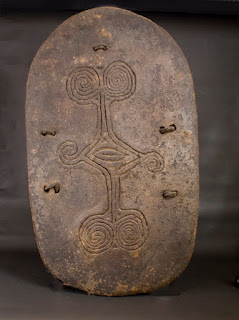Shield
Ht. 42 1/2"
Lumi, East Sepik, Papua New Guinea
1st Quarter 20th Century
Mindja Figure
Nukuma, Washkuk Hills, East Sepik Province, Papua New Guinea
Ht. 68” First half 20th century
Wood, paint
Two groups live on and around the Ambunti Mountains: the Kwoma and the Nukuma. They are often incorrectly referred to collectively as the Waskuk or Washkuk. Both cultures are yam-based, unlike the sago-based cultures of the Middle Sepik. The annual yam cult cycle uses three terms to refer to the complex rituals and to the objects and social groups associated with them. Yina, Mindja and Nogwi carvings are linked with their respective ceremonies which take place after the yam harvest. "A variety of carvings are made by the Kwoma and Nukuma people that are used in both age grade rituals and ceremonies relating to the cultivation and harvesting of yams. Mindja, one of three types of carvings are recognizable by their large size, prominent nose, and rows of upturned spikes or spears that represent snakes. Mindja carvings are said to represent water spirits living in the lakes that are sometimes seen just under the surface of the water. Each Kwoma clan owned a pair that was shown in rotation from year to year. The term mindja applies to the rituals, the sacred objects, and the social divisions." (Newton 1971:82-87)
Nukuma, Washkuk Hills, East Sepik Province, Papua New Guinea
Ht. 68” First half 20th century
Wood, paint
Two groups live on and around the Ambunti Mountains: the Kwoma and the Nukuma. They are often incorrectly referred to collectively as the Waskuk or Washkuk. Both cultures are yam-based, unlike the sago-based cultures of the Middle Sepik. The annual yam cult cycle uses three terms to refer to the complex rituals and to the objects and social groups associated with them. Yina, Mindja and Nogwi carvings are linked with their respective ceremonies which take place after the yam harvest. "A variety of carvings are made by the Kwoma and Nukuma people that are used in both age grade rituals and ceremonies relating to the cultivation and harvesting of yams. Mindja, one of three types of carvings are recognizable by their large size, prominent nose, and rows of upturned spikes or spears that represent snakes. Mindja carvings are said to represent water spirits living in the lakes that are sometimes seen just under the surface of the water. Each Kwoma clan owned a pair that was shown in rotation from year to year. The term mindja applies to the rituals, the sacred objects, and the social divisions." (Newton 1971:82-87)
Bark Painting
Ht 17 1/2 W 34 1/4"
Australia
YIRAWALA (c.1897-1976), artist and Aboriginal elder, was a member of the Naborn clan of Gunwinggu language speakers, whose traditional lands lie in the Marugulidban (also called Morgaleetbah) region straddling the Liverpool River, south-west of Maningrida, Northern Territory
Mask
Ht. 21 1/2"
Murik Lakes, Lower Ramu River, Papua New Guinea
"This mask is used in ceremonial dances. The mask is not worn directly on the face, but is part of a towering cane dance framework (tumbuan) covered with thousands of feathers.We saw 6 frames being constructed in 1986 at Banis Pig near Bosmun. A large area (banis) had been fenced off with high woven mats (blind) in front of the men's house. Only initiated men worked in this banis. Each frame was about 12 feet (4 meters) tall and quite narrow like a bulbous spire. Brilliant red, yellow, white and black feathers were applied in flat, over-lapping layers with the same density that flowers are put on a Rose Bowl Parade float. Photos of similar tumbuans from this area show fan and cone shapes.
The tumbuans were to dance at the next full moon, about two weeks away, if they were finished. Otherwise, they would appear the following moon. The men didn't mind if we watched them work, but no photos were allowed. During the ceremony, colorful leaves, flowers, fruits and massive displays of white shell jewelry are added to each costume. A long, full grass skirt is tied along the lower edge of the cane to conceal the dancer inside." www.art-pacific.com




No comments:
Post a Comment